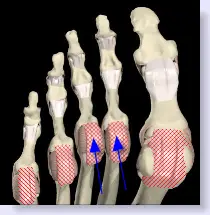
It starts as a twinge of pain on your heel every morning you step out of bed and onto the floor. And by the time you've walked around for a few minutes it's gone. Except as the weeks go by, that little annoying pain seems to last longer and longer. You think it's all in your head, and before you know it, it's a throbbing pain severe enough it leaves you limping every time you exercise and have to put pressure on your feet.
For an avid runner, that pain is debilitating. It happened to me in September of 2008. I consulted with other runners, massage therapists and foot specialists, and the diagnosis was the same: plantar fasciitis.
I tried everything, deep tissue massage, traditional rehabilitative therapy, and orthotics of all kinds including an awful, enormous orthotic boot I have to wear to bed at night that keeps my foot propped at a ninety degree angle. Its purpose is to keep the muscles in my foot and calf from tightening up which is partly what leads to the heel pain. Well, after a night wearing that, my foot feels better in the morning, but the rest of me is exhausted because I didn't get a wink of sleep.
Over a year later, I still have plantar fasciitis. I had to limit my running to once per week. Foot specialists suggested I either stop running, get a cortisone shot that basically numbs the pain, or try foot surgery to cut part of the plantar fascia. This is the tough, fibrous band of tissue that connects the heel bone to the base of the toes. Eew! I am still not going for either of those last two options.
Then there is accupuncture, which I have yet to try, and something called Airrosti which I finally did try after several friends recommended it and swore by it. Chris Marrou says it helped him treat a shoulder injury and Jennifer Broome, from WOAI, has regular treatments for her IT band. The iliotibial band is a tough group of fibers that run along the outside of the thigh. The gluteal muscles and the tensor fascia lata muscle attach to the top, and the lower part attaches to the tibia, just below the knee. It functions primarily as a stabilizer during running and can become irritated from overuse. (www.rice.edu)
Airrosti stands for Applied Integration for the Rapid Recovery of Soft Tissue Injuries. It is a technique that developed in the last few decades, but only recently has taken off mostly in Texas. It is used to treat both acute and chronic musculoskeletal injuries. Airrosti practitioners rehabilitate shoulder, back and other soft tissue injuries in a very short amount of time. The result is avoiding major surgeries returning to normal activity much quicker. Three to six one-hour sessions are what most patients require.
Simply described, Airrosti is an intense, deep tissue massage of the injured soft tissue areas. For my plantar fasciitis, Dr. Jason Garret, ran his thumb along the fascia of my foot and up the muscles of my calf. Really, it's more like mashing his thumb along the ligaments and it hurts! A lot! The idea is that he is smoothing out the tightness and knots that have developed over time contributing to the injury.
After three treatments, I am up to running three times a week! I am still in some pain, and I am on a exercise plan that includes regular stretching excercises using the foam roller. I roll it along my IT band up to my hip, my quadraceps, and my calf and I think it's been a major help. I am not fully rehabilitated from my injuries just yet, but I feel I am on a good path and will stick with it for a while. I let you know how it goes!







